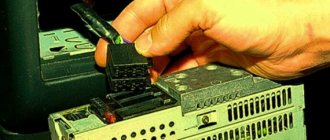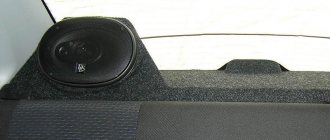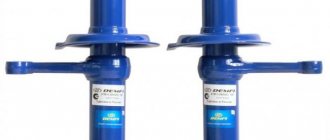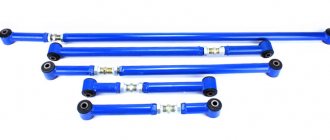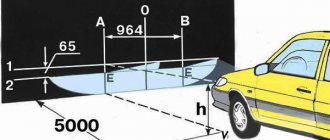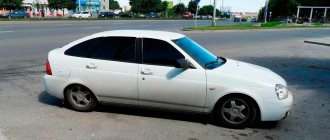Speakers 16 cm in the door
and used a jigsaw to cut out what was unnecessary.
By the way, here are the approximate dimensions, the rest can be adjusted according to location
as a result this was born
then I roughly estimated it on the upholstery and drew
first fitting and comparison of 13 and 16 speakers
nothing interferes, nothing touches
I placed the plywood insert on the sealant and screwed it to the door, the speaker was also on the sealant
put the upholstery and plastic in place
I decided to put the tweeters on the triangles of the mirrors, temporarily for now, maybe I’ll cut down the podium later
Well, on the right everything is similar and it turned out faster
Source
Homemade shelf
Acoustic shelf Hyundai Accent homemade
It’s no secret that you can also construct a homemade shelf with your own hands. Below are instructions on how to quickly, without spending a lot of money, time and effort, build a pretty decent acoustic shelf from plywood.
An acoustic shelf made on your own even has more advantages:
So, let's get down to actual production. The optimal option for a Hyundai interior, both in terms of cost and quality, would be the installation of 4 speakers. Front acoustics with 2 speakers will take on the main role. But all the same, without the support of the rear, no acoustics will sound normal. Therefore, two speakers are also placed at the back on a homemade, in this case, shelf.
DIY acoustic shelf Hyundai Accent
To build a shelf that would allow the installation of oval 6x9" speakers or 20-centimeter speakers, you need to prepare the following materials:
Acoustic accent shelf and its template
Hyundai Accent acoustic shelf reupholstered
During the work process, it will be useful to watch a detailed video review and study thematic photo materials. There are many practical guides for assembling the rear acoustic shelf. Some instructions (which describe the process in more detail than here) can also be found on our website.
Door trims "Lux VAZ 2110-12" + mounts for 16th speakers.
Hello.
In previous entries I talked about the multiple preparation of doors and door cards (technical hole plugs, backlight lamps, ESP control unit).
Today we will talk directly about installing the skins. I’ll be honest, the process of installing “Lux” cards was simply painful! The skins themselves are great, but the fastenings... I heard about the problems, prepared, tried them on, but to be sure: D During the hasty fittings, I didn’t notice any serious problems. The discrepancies were not great, the largest “run-up” of the fastenings was about 4mm. If we consider individual fixation points, these are all little things. But when you need to latch at once (all six pistons), then millimeter distortions result in very big problems. By the way, from the factory there are 8 clips per door, here on all cards there are fewer! About the process. 1) Selection of pistons, clips.
There are a huge number of them, but due to the peculiarities of the fastenings, only “herringbone” ones are standard (1)
.
Feature: inserted into the hole. I liked the white ones from Priora and the yellow ones from Largus (2)
. At first I tried to remake the fastenings for them (grooves instead of holes).
I attached the clips, but later during the installation process they did not fit. It turned out that in addition to the shift to the right/left and up/down, there is a jamb with long fastenings (plastic platforms). Most of them are not pressed against the metal and remain at a distance, leaving no opportunity for the clip (Largus or Priors) to snap into place.
Further, the so-called “Euro pistons”
Stopped on them. Reviews about Euro pistons are good and the price is not high. Made from normal materials, moderately soft and not hard. Compared to other options, they are dismantled with less effort, for example, from the same viburnum they simply cling tightly (there is a high risk of breaking off the soldered holders from the casing).
2) Accessories for assembly.
New (standard) internal velvets and a replacement for the original “fungi” - lock release button 21700-6105125-00 (Sold as a set, bushings 21700-6105129-00 are not needed). Taped corners of the rear doors.
Front door trims without holes and inserts into handrails. Old scratched handles had to be replaced on all doors.
3) About the nuances of assembly.
Everything is clear with the fastenings, there was a complete collapse. In addition, it was necessary to return the ten-point locking rods to their place; the priors have a different bend and length. The locks were installed from 2170 along with the rods!
In general, the velvets snap in place normally, they rise a little at the edge due to the fact that they fit on the ring around the button (can be trimmed).
The handles are very tight in several places; I had to trim the hole to press it tightly to the card. Moving plastic parts were greased with Permatex white lithium grease
, now when opening the doors there are no extraneous creaking sounds (door opening handles, pulls). Otherwise, everything is fine) The triangles fit into place.
In addition to the clip mounts, there are 12 places for self-tapping screws; I didn’t give them up. Extra fixation won't hurt! Bought from a hardware store, painted black. The original screws turned out to be short.
Source
Hyundai Accent › Logbook › Actually, something that has been standing for a long time. Acoustics in my car.
So I decided to write what was actually done regarding the sound in the car during the two years of ownership. First of all, when I bought the car (it had a cassette radio), it was decided to buy a new radio. It was decided to buy an inexpensive mafon with three outputs for amplifiers, for subsequent connection of all components through amplifiers... I arrived at a local Pioneer store and chose this from everything that was offered to me:
Before: Art Sound AS 6.2 (left over from my eight) the cost was about 4500 rubles.
Since spacers had to be placed under the front, it was decided to make the front doors noisier. The material used was vibroplast STP + splen from the same company. There is no photo of the process, there is only the final result:
I am pleased with the result of the door noise. The noise became a little less, the door closes with a slight movement of the hand, the sound when closing is dull... In general, everything is as it should be... Next in line was installing the “pancakes” back. For these speakers, I made an acoustic shelf from 20mm plywood and covered with gray carpet. There were no problems with the shelf. I did this: I took off the original shelf, put it on plywood, traced it and cut it out. Next, so as not to miss the holes for the speakers, I put the cut out shelf in place as it would stand and from the trunk side with a marker I traced along the original holes in the steel shelf... And only then, based on these marks, I tried on the speakers, how it would all be, marked it out and cut it out . I tried everything on, was glad that it worked the first time and didn’t screw up anywhere and covered it with carpet... The most difficult thing was to connect the shelf with the speakers already in place))) Because. The shelf with the speakers already screwed in would not fit through, and if I first put the shelf down and then screwed in the speakers, I couldn’t get a screwdriver under one screw... In the end, I don’t even know how, I managed to crawl up and screw the speakers onto the shelf already in the car... The shelf itself I screwed it with self-tapping screws of the required length through the holes of the steel shelf through the spacers between the steel and acoustic shelf. Overall I'm happy with everything. The bottoms on the pancakes were very pleasing... I didn’t think it would be so good. Many who rode behind me asked what kind of subwoofer I had... And this is without an amplifier.
Then, about a year later, I found out that a friend had an unnecessary Mac Audio amplifier, but he didn’t want to sell it separately, but sold it together with a Signat 12″ sub and a 2 farad capacitor for 3000 rubles.
The case was, to put it mildly, not a fountain... And having acquired the whole thing, I decided to make a new case for it. This speaker was tested on the car audio website, here is a link to the article: www.avtozvuk.com/az/2004/…/htmdoc/120-145signat. htmFrom which it became clear that the housing for this speaker must be at least 30 liters, there is no more sense. I wanted to make the housing with minimal loss of trunk volume, but with the required displacement. I measured everything in the trunk that I needed and went to look on the Internet for how to calculate the housing for a subwoofer... in the end I calculated everything on an online calculator. There you enter the dimensions of the sides that you need and he gives you the displacement that you will receive in the end. Now for some reason I can’t find this site... But I didn’t save the link...(((For the body, 20mm liquid nails, wood screws (were), soundproofing material Biplast Premium, and naturally dark gray carpet were purchased. All joints before tightened with self-tapping screws, were coated with liquid nails, and also inside and outside, all joints were again covered with the same liquid nails. When the body was almost ready, Biplast Premium was glued on the inside
Next, I closed the case with the front wall and glued it onto the same Biplast Premium. Then I covered everything with carpet. It was decided to attach the amplifier to the back wall of the subwoofer, and the capacitor to the side. I bought the wiring as a ready-made Mystery kit:
And I routed everything on the driver's side. The power wire was pulled from the engine compartment through a wiring hole with a rubber membrane. As a result, in the trunk it all looks like this:
Overall, I'm happy with the sound at the moment. Everything was set up so that the sub would simply play along with the music exactly as much as I considered necessary. The goal was not to destroy the glass on neighboring cars and houses, as well as my own ears... As a result, the amp was turned up almost to the minimum, and the bass was soft and pleasant. In general, I am very pleased with how everything turned out in the end...
Thanks to everyone who mastered so much text!))) I wrote from the heart))) If you have any questions, ask, I’ll try to answer)))
Installing audio speakers in the front doors
In VAZ cars of the “tenth” family, the installation of front speakers is provided in the windows of the internal panels of the front doors. The window sizes are designed for speakers with a diameter of 130 mm. An important point when installing speakers is the method of routing the wires from the head unit to the speakers. As the doors open and close, the wiring harness located between the end of the door and the body pillar will constantly bend. Therefore, the wires should be reliably protected.
The wire can be taken out from under the instrument panel and passed under the door trim. In this case, the wire in the cabin will be constantly visible, which is not very aesthetically pleasing. In addition, such a wire can easily be damaged, and in the place where it goes under the upholstery, the upholstery will not adhere to the door. This, in turn, will lead to loosening of the upholstery and, accordingly, rattling and squeaking when moving, which will certainly appear after a short time. In addition, the upholstery, constantly acting on the wire, will grind it. This method of laying wires can only be considered temporary.
In order to lay the wires more thoroughly, special holes are provided in the A-pillars and the ends of the doors. However, simply passing the wires through the holes is only half the battle, since vibration will quickly rub the insulation of the wires against the edges of the holes. Therefore, to protect the wires, it is necessary to install a corrugated casing between the door and the stand. Such casings are commercially available and inexpensive. Speakers are usually equipped with connecting wires. When connecting speakers to the head unit, it is necessary to take into account the polarity of their terminals.
Source
Installing audio speakers in the front doors
Die-hard motorists value a good audio system just as much as a good engine. It is she who is the driver’s constant companion on long-distance trips and an indispensable assistant for car repairs in the garage.
Today I would like to talk about a separate element of any car music system - acoustics, or speakers. The sound quality of the entire system will depend on the correct selection and proper installation.
So, what types of car speakers are there and where is the best place to install them?
How to choose the right speaker size:
By opening the speaker protection (grills), you can easily determine the speakers of what diameter you need. Now let's talk about the subtleties that you may encounter.
It is a great success to fit tweeters into standard places without modifying them, therefore, when installing tweeters, standard mounting points are usually modified.
When installing speakers in a door, you should take into account their depth, because... Excessively deep speakers will interfere with the glass.
Having decided on the budget and the required size of speakers, we will begin selecting new components.
Installation of 16 speakers in Priora
When installing non-standard speakers, change the speakers in the front doors of the Priora, then in the rear and on the trunk shelf. Additionally, audio components are mounted in the rear doors.
Speakers for the front doors of Priora
The first stage of installing the speakers is removing the interior trim in those places where the components will be installed, in this case the front door panels. For good sound, noise and vibration insulation (NVI) of the car body elements in which the radio speakers are installed is necessary. Therefore, in its absence, it is advisable to use the disassembled state of the front doors and glue vibration and noise insulation material.
Installing the speakers from the front involves cutting metal, since the standard holes are designed to mount speakers with a diameter of 13 cm. The easiest way to do this work is to use a jigsaw with a metal file.
First you need to mark the metal of the front door, for which you use a template cut out of paper or cardboard according to the size of the column. Sometimes a ready-made template is included with the audio components. Move the center of the new hole straight up, in this case the 16 cm speaker will not interfere with the fastening of the front door trim.
After cutting out a piece of metal, to prevent corrosion, it is advisable to treat the edges of the hole made with an anti-corrosion compound, or better yet, prime and paint.
The place where the speakers are mounted is covered with noise and vibration insulation. If there is no material, foil-coated isolon is suitable. To prevent the transmission of vibrations from the speaker, it should be installed through a spacer made of plywood or similar material, which is also covered with sound insulation. The radio speaker is attached to the spacer with self-tapping screws.
It is necessary to cut off the plastic edge of the door card located around the holes in front of which the radio speaker is installed. After that, all that remains is to connect the audio cables, assemble the casing, and you can enjoy the improved sound.
In addition to radio speakers, some audio systems include crossovers and tweeters (tweeters). As a rule, the crossover has a place on the front door map, and the tweeters are installed on the triangular elements of the interior trim opposite the place where the side mirrors are mounted. Advanced acoustic systems require the installation of tweeters on the A-pillars.
How to install speakers in the rear doors on a Priora car
There is no standard place for installing rear door radio speakers. Therefore, in order to install speakers in the rear doors, it is necessary to cut out part of the door trim. The internal space of the rear doors is limited; installation of speakers with a diameter of 16 and even 13 centimeters requires the manufacture of a spacer. If it protrudes beyond the door, it is sheathed with carpet, leatherette or other material.
Back to rear shelf
The rear shelf is a place for oval speakers. Among the manufacturers, pay attention to JBL. If necessary, holes on the shelf are cut to fit the size of the speakers to be installed. The material of this part is quite soft, so it cuts easily.
Acoustics for a VAZ 2112 car
Acoustics for a VAZ 2112 car
already exists, but it is weak and needs to be replaced. In order to remove holes from the door, it is recommended to take a sheet of aluminum about one and a half millimeters in size. This thickness makes it easy to adjust the sheet to the shape of the door, and if you also make noise insulation from vibroplast underneath it, then when knocking it will resemble wood.
In order not to make a mistake in the sizes, you need to make templates from paper, then take rubber scissors, attach the template and carefully cut out. All this needs to be secured with self-tapping screws. But the vibroplast prevents complete sealing, remove the foil from the material and the problem is solved! Under the foil near the vibroplast
This is already a separate case. All this work was done to ensure that the doors did not rattle or make noise. It all depends on the acoustics you install. Not everyone likes powerful music, but our tuning is designed just for hammering. As a rule, we place a subwoofer in the trunk of a car, because it takes up a lot of space in the cabin, and there is a feeling of surround sound if it comes from the rear. It is advisable to make complete sound insulation of the VAZ 2112 car
, Shumka, doors alone are not enough. The work does not take much time, it is quite possible to do it alone. If a professional does it, and more than one, then the work will be done in a very short time; it is recommended to prepare in advance all the tools and materials that will be useful in the process of completing the work. You also need to work in a warm room, the glue should grab everything, but in a cold place it will simply harden. We select the size of the holes according to the diameter of the speakers installed on the car. All contacts must be well insulated in order to prevent fire.
Why do you need to install so many speakers:
Since the time of the first manufacture, people have realized the advantage of the division of labor. Similar benefits can be obtained from the “division of labor” of speakers. Each speaker must play its own frequency range: tweeters - high, mid-bass - middle frequencies, subwoofer - low. Installing speakers for each range will allow you to get the highest quality sound and audio stage.
An audio scene in a car is the construction of a system in such a way that during playback you can clearly “separate” the sound locations (the direction where the individual instrument is located), i.e. as if you are in front of a real stage.
Adviсe
Technically, installing music yourself in Lada Vesta is not difficult. By adhering to a few simple rules, any motorist can handle the work. Consider these rules:
- All work must be done very carefully to avoid damage to the plastic upholstery;
- The car already has audio preparation; you only need to install harnesses to connect the front speakers;
- You cannot cut off standard connectors, but you need to buy and use adapters;
- Before installing audio, it is recommended to soundproof the Lada Vesta doors to obtain improved sound characteristics;
- Install the speakers on the spacers.
Audio preparation is measures carried out by the manufacturer (laying audio cables, installing speakers, etc.) that simplify the process of installing music for the car owner. Depending on the configuration of Vesta, audio preparation may be different.
What speakers to put in car doors
While two-way speakers satisfy most car enthusiasts, those who love good music require better speakers. A good model for any car would be the three-way coaxial speaker system PioneerTS-1339. The compact size allows you to install the speakers in the doors of any car. Users note the high sound quality and reliability of the design. The Pioneer coaxial speaker system provides a power of 40 watts, which at its peak reaches 200 watts, and such an increase in power has almost no effect on the sound.
The sensitivity of the dynamic heads at 91 dB allows the speakers to be connected to any low-frequency amplifier. Users note that an additional amplifier is not required for normal operation of the acoustics, since the Pioneer 1339 works well with standard equipment. The complete acoustics of a car can consist of four similar speakers, with two working as front speakers and two as rear speakers.
Coaxial and component speakers, what are they:
The coaxial speaker is designed to reproduce the entire range of frequencies and combines a high-frequency and mid-range speaker. They come in one, two and three-way - which looks like additional speakers located on the main body and are designed to reproduce, for example, high frequencies).
Component speakers are actually a set of two, rarely three pairs of individual speakers, each pair of which reproduces a different frequency range. The division into the range occurs on the crossover, which is included in the kit. The principle of operation of a crossover is to cut off an unnecessary part of the range for each pair of speakers, for example, for tweeters, the middle and lower parts of the range are cut off.
Variety of speaker systems
Acoustics for cars are conventionally divided into the following types:
Coaxial acoustics - produced in the form of a complex structure, always consisting of several speakers placed on one suspension. This is usually one or two tweeters and midrange speakers, and one woofer. This type is more affordable and makes it possible to obtain higher sound quality compared to standard car systems.
Please note: it is difficult to recommend or not recommend this type; if you purchase a speaker system from a trusted manufacturer or a well-known brand, then the design, price and quality of the sound stream will vary. We advise you to carefully read the technical characteristics of the system and the material before you buy. It's better to listen if possible.
Component acoustics - includes several separate speakers: a low-frequency speaker for transmitting low frequencies, as well as a tweeter for high frequencies. As a rule, the manufacturer also provides a crossover, which is made as a separate unit, which is responsible for separating low frequencies from high ones. This type is much more difficult to install, is more expensive, and compared to a coaxial system it has better sound quality.
The main advantage is the ability to choose the location for mounting the tweeter. The disadvantages include that installation requires knowledge of setup and installation, as well as cutting holes yourself.
Rear shelf Hyundai Accent
After I put on the music, the rear shelf was left unfinished. It itself was already quite faded, the speaker grilles were scratched, and in some places stained with some kind of ink, probably because the previous owner was carrying a small child in the back.
I thought about it and decided not only to make it noisier, but also to refresh it a little, namely to change the speaker grilles and reupholster it with a dark gray carpet.
I removed the shelf while I was playing music, the manual from the club forum helped. By the way, it was holding on for me with just one and even a broken piston. It seems that it was already dismantled and put back together before.
First of all, I glued the metal with the remnants of STP SIlver and STP Gold, and drove like that for a week until the next weekend))
I really wanted to change the grids to those that were included with the speakers, but without surgical manipulation it seemed to me that this would not be possible to do as I would like. Standard plastic ones stick out quite a lot, and if you put a carpet over them, and then attach a new mesh, you would end up with something mountainous and wavy, which is not at all what you wanted.
It was decided to farm a little)
I bought a couple of sheets of 2mm plexiglass (320 rubles per sheet) to cut out something similar to a spacer that would be inserted into the recess of standard meshes. A screwdriver and an emery machine will help. In short we have the following:
Now the problem arose of how to remake the wells into which the sound comes from the old meshes to the new design)) First, they had to be cut off with a knife or cutter:
To somehow glue these two things together, I first tried epoxy glue, but it didn’t work ((After drying, I pressed a little and everything fell apart.
The collective farmer in me woke up more and more and came out with the following: I pasted over the earlier cut part with an accent, and screwed it together on plastic corners, after which I placed the entire structure with glue from a can to the shelf itself.
Having made sure that everything was holding up pretty well, the process of removing the shelf from the inside began:
Now it's a matter of small things. We cover it with carpet, placing it on spray glue. We fasten the landing sides from the new nets, put on 4 new clips, cut off the excess carpet, cut holes for the speakers and the lampshade, screw the lampshade and go to install it on the car.
It fits back quite tightly, all the clips snap into place normally, nothing interferes with the speakers))
By money:
Glue - 480 RUR. Carpet musical dark gray ACV 1.5m x 1.0m - 290 RUR. Clips - even 150 rubles for 10 pcs.
It seems like it turned out cool, plus there are advantages in sound and appearance)
I was going to do it!
Everything is not as complicated as it seems.
The operations are all painfully simple: remove the shelf, remove the rear speakers, get rid of dirt and dust, degrease, glue vibroplast;
We take the shelf: we get rid of it, glue the vibroplast, then the accent, put it in place and rejoice at the result! Thanks to everyone who suggested and helped with advice
(“How to remove a shelf?”, “Should I leave the rear?”, etc. There were a lot of questions due to ignorance, but that’s in the past!).
PS I decided to remove the rear speakers for good a long time ago. Loud front + sub decides, the rear is of no use and never was!
By the way: I sealed all the technical holes so that the bass came out into the cabin only through the holes in which the speakers were placed. The glued shelf no longer jumps with a roar from the bass, and the bass itself has become longer and lower! I did it, sat down, turned on the mayfun and BAAAAAA! The sound is excellent! (one thing that upsets me is that the front door trims are jumping
But that's next!) At the end - photos of a clean car!=THANK YOU FOR YOUR ATTENTION!=
Acoustic shelf Hyundai Accent
The Hyundai Accent acoustic shelf is designed for the correct installation of speakers. This shelf no longer vibrates during operation. An Accent acoustic shelf is especially recommended if the speakers are large. The frail factory shelf in a Korean car is in no way capable of supporting powerful speakers, and they won’t fit there, since the standard seats provide for smaller speakers.
How to choose speakers for yourself:
There are two fundamental types of speaker selection: listening at a stand and selecting on the Internet. Each of them has its own advantages and disadvantages. At the stand you can hear the speakers in color, compare several manufacturers, choose the best option, but it is worth considering that in the car they will, in most cases, play differently. Choosing from reviews on the Internet allows you to buy the best option in terms of price-quality ratio, but everyone’s hearing is different and what plays well for one, for another is a chaotic set of sounds. The same set plays differently in different brands of cars. Choose speakers according to your preferences, because each speaker, as well as audio systems, are designed for certain types of music, be it classical, rock or club music. You can read about the quality of playback by a particular speaker of your favorite genre of music on specialized forums.
Welcome to the website https://lada110atricom.ru
We set off on the road, drove and drove, and finally arrived. Let's go to the market.
There were a lot of cars in Saratov, some not for our money, others too dead, in general, we wandered and wandered and saw a red VAZ2110 (my favorite color). After some time, after a lot of walking, it was finally decided to buy the first car I liked and finally go home.
The path to home was not close, about 200 km. At first, I thought that my friend would drive and drive my car to my native Kamyshin, but I still drove it back myself. This is my very first time when I drove for so long, because the last time I held it in my hands was back in February and that was for about 10 minutes. For the first 10-20 minutes I couldn’t come to my senses that I was sitting behind my own car, My hands were shaking a little and I still couldn’t believe that I was going. Literally, after driving 50 kilometers, I already began to feel much more confident, fell back on the seat and began to enjoy the trip.
Everything would be fine, but in Krasnoarmeysk at the traffic police checkpoint we were stopped to check our documents. And I stupidly took only my license with me, and the rest of the documents remained with my mother, who drove ahead in another car with a driver. Luckily they stopped about 300 meters from us. The inspector had to wait for some time, to which he made a menacing expression on his face. They brought the documents, checked everything, but still got to the bottom of the fact that there was no first aid kit, fire extinguisher and sign. And the fact that the car even had transit license plates and had just been purchased did not bother him; he had to pay some fine to the Inspector’s fund. We got into the car, refueled and hit the road.
We got home quickly, we drove for about 3 hours in total, although it could have been longer, but I was still a beginner at that time, and the car was not tested, you never know what would break down, so I kept the speed around 100-110 km/h . But still there was a desire to experience the drive and therefore I accelerated once to 155 km/h, the car behaved amazingly on the road, I remained satisfied throughout the journey.
Express your opinions about my work, and just like that, we can discuss something, further work, plans.
Source
Speaker sizes
Before you buy acoustics, you should understand that devices from the same series often have different design features. How to correctly determine what is most important – a presentable appearance or speaker parameters?
The car owner chooses the speakers at his own discretion. The choice depends on the type of system, the size of the car interior and the musical preferences of each individual.
In the event that it is not possible to increase the staff position. This problem is due to the characteristics of the car or the complete lack of other options for installation.
Speakers with a diameter of 20 cm or 8 inches are considered common. Such models are perfectly combined in three-component acoustic systems. They play the role of a high-frequency link and ideally reproduce average vibrations. Huge speaker models are both an advantage and a disadvantage. They require special effort and experience to install in the front door.
Quite rarely, but still used, two-component systems; their sound quality is much higher than that of coaxial ones. The most optimal use case would be a 20 cm speaker in an acoustic system that does not have a subwoofer.
Currently, manufacturers do not use 6.5-7-inch speakers in the presented models, although they have improved capabilities for reproducing low-frequency vibrations.
We recommend that you familiarize yourself with the speakers, which have a diameter of 13 cm or 5.25 inches. This option is perfect as rear voice acting in a front speaker system. Suitable if there is not enough space in the car showroom for installation work. According to experts, it is better to refrain from such experiments; the systems are limited by bass. If, when replacing the standard system, it was discovered that it is not possible to install speakers of this size, we recommend considering oval models, the diameter of which is 13x18 cm or 5x7 inches.
Quite often they ask about models with a diameter of 10 cm; in this version, the reproduction quality is significantly low. When choosing these models, you should understand that it is better to complement your acoustic system with bass support, for example, midbass speakers.
When choosing a particular model, drivers usually look for inexpensive products. Remember, if you are interested in sound quality, take a look at other options that experts advise. The total cost of such speakers is significantly higher than for 16.5 cm coaxial models.
A fairly good option that deserves attention are three-component systems with diameters of 16.5 cm, 10 cm and HF with a built-in crossover. This type has a compact size and is more difficult to integrate into the front part of the car interior.
Important: all manufacturers recommend paying attention to small speakers that are easy to install. When considering such options, remember that all other characteristics automatically deteriorate: the tonal bass is automatically disrupted, the quality of midbass transmission itself decreases, and these are quite good reasons to think about it.
Website about joints
I was tired of the constant rattling of the rear shelf and so I decided to get confused and made a new shelf with my own hands
and so we take two pieces of plywood like this...
and cut out something like this. In order to cut it out, we take the old shelf and lay it on top of the plywood that is above in the photo, outline it with a marker and use a jigsaw. I made two such templates, the second one is about 1 cm narrower, along a curved arc that is located on the glass side. I did this because there will be fewer adjustments in the future
this is how it turns out, two cut pieces of plywood
try it on. We make the smooth edge of the plywood flush with the reinforcing strut of the body. if it sticks out, we cut off the edge of the glass, but don’t get carried away so as not to overdo it
After making adjustments on site, we take the first measurement from below, insulation on it, and the second cut plywood on top. We mark, use a thin drill to make holes so that the self-tapping screw fits better, and tighten them tightly in a circle. This is done so that it is stiffer and does not rattle
marking the places for the speakers...
but here it’s up to everyone... I decided to paint on both sides. This is the outside side, that is, from the trunk. and one more thing, if you decide to paint, then before painting you still need to go through the screws; in the next photo you can see exactly where. We pass the edges with sandpaper and sand until there are no sharp edges
Read also: Electric chair massager
Here you can see where to go with the screws. inner side, from the salon
After the paint has dried, we attach the shelves so that they do not rattle like the factory ones and sit rigidly. unfortunately I forgot to take a photo. I made them this way: when we remove the seats, from the trunk side we see three lugs on the body amplifier, put the shelf in its place and make marks so that the bolt that will be the mount goes into this lug, this is the front mount. As for the rear, we open the trunk and climb into it)))) what do we do next, and then we see under the rear window there are two protrusions on the left and right, so, we make marks along the edge of these protrusions and go together with the shelf to make fastenings, I bent I put it on the screws from the tin, after which we put the shelf back and climb into the trunk, there are holes in the protrusions, we make marks on the tin, we make marks, the fastenings are ready. All that remains is to screw it on. I almost forgot, it is advisable to take the front bolts with a screwdriver head, insert them into place and tighten them, since then you will not secure the shelf firmly. According to the fastenings, everything seems to be all right. The writing seems scary, but in reality there is nothing complicated.
after the fastenings are ready, we take the insulation and lay it in three layers...
...the first and third layers are white. This is door trim insulation, you will have to buy it at a hardware store if you want to cover the shelf with leatherette, and the middle layer is made of ordinary insulation with glitter. We also buy it from the construction store.
we cover it with leatherette and put the speakers in place.
We put the shelf in its place and secure it. the resulting hole will be repaired later
We measure the holes, cut out one layer of plywood, then everything is the same as with a shelf, insulation in two layers and upholstery with leatherette. everything is secured with a construction stapler. fastened with three self-tapping screws. you can see in the next photo
here is the final result. good luck to those who bother to do the same as me
Acoustic shelf VAZ 2110
The acoustic shelf of the VAZ 2110 is made with your own hands if the standard one is not satisfactory for various reasons. Firstly, the factory shelf cannot in any way improve the quality of car audio that the owner so desires. Secondly, the factory shelf does not make it possible to install speakers with a wider diameter. On the VAZ 2110, the acoustic shelf can be made independently without any problems, although it can also be purchased at some store.
